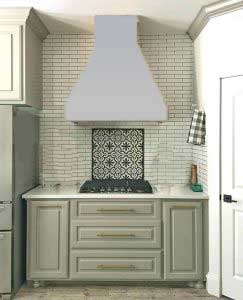There are several places and appliances in your home that need proper venting, including the  bathroom, dryer and stovetop. Let’s look at the specific requirements for each.
bathroom, dryer and stovetop. Let’s look at the specific requirements for each.
Bathroom Venting
Your bathroom exhaust fan should vent to the outside of your home, either through a side wall or the roof. Your fan should never vent into the attic space as this can cause warm, moist air to create mold and mildew conditions and compromise and rot your wooden roof framing and sheathing. When the weather is cold, the moisture in the vented air will cause condensation inside the attic that will drip onto the flooring and insulation and causing rot.
Dryer Venting
Your dryer’s exhaust vent must expel to the exterior of the house in order to remove the heat and moisture created. It should never be vented into the garage, attic or soffit areas, or crawl spaces under the house. Improper venting can add moisture to these areas and create mold and mildew problems that lead to rot and insect infestations. Lint buildup from the dryer can create a fire hazard as well.
Your dryer vent serves the dual purpose of also removing combustion gases if the dryer runs on natural gas or propane.
Building code requirements state that a dryer duct be no longer than 25 feet long, with additional regulations for every bend in the duct. Flexible ducts are not recommended as they can collect more lint and block the flow of air and combustible gases, backing dangerous carbon monoxide up into the home. Metal ducts are recommended. Where the duct vents to the outside of the home should be at least three feet from any other opening in the home and be covered with a termination cap and damper to prevent animals from entering the duct. A screen should never be used, as this can trap lint and cause a fire.
Common problems with dryer vents include:
- Lint buildup or lint blocking a too-small opening
- A screen over the vent
Stove Venting
Your stove has a range hood with a fan above it that is there to reduce the amount of heat, steam, smoke, grease and odors that are the byproducts of cooking. There are several types of stove ventilation systems: an exhaust fan, a range hood and a ventilation hood. The types and sizes of ventilation systems is generally chosen by the energy output of the stove.
- Electric stoves and electric deep fryers require a ventilation output of 150-300 CFM.
- Gas stoves require a range hood capable of removing 100 cubic feet per minute for each 10,000 BTUs of burner output. For example, an output of 40,000 BTUs requires a 400 CFM fan.
- Professional stoves that put out a large amount of heat require a higher CFM determined by the number of BTUS put out by the stove.
The range hood should be installed no higher than 24-30 inches above the stovetop and span the stove’s width and most of the depth.
There are a number of options for stove venting including an updraft system with a range hood hanging over the stove; a downdraft system that pulls air through vents in the cooktop; and a ductless or recirculating range hood. Venting to the outdoors is optimal, but if the home is in a high-rise building, recirculating venting is often used. Whatever type of stovetop vent system is used, the filter should be changed often.
Related: Ducted vs. Ducted Range Hoods
Let Först Consulting Group Inspect Your Home
At Först Consulting Group, we’re experts in inspecting homes for code violations such as improper venting. We’d be glad to perform a Building Pathology Inspection to ensure your home is safe and healthy, or a Construction Defect Inspection should you suspect that your builder or contractor has made a mistake in a building process.
Don’t wait until improper venting creates damage or a fire. Ensure that your venting is installed correctly to building code standards. Contact Först Consulting Group today to schedule your inspection.




